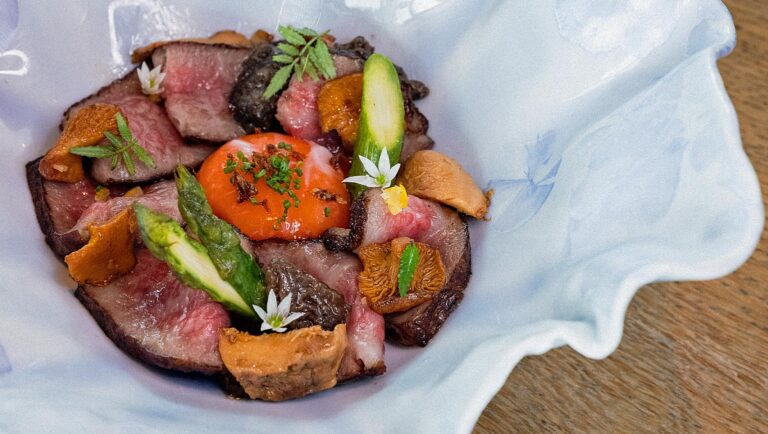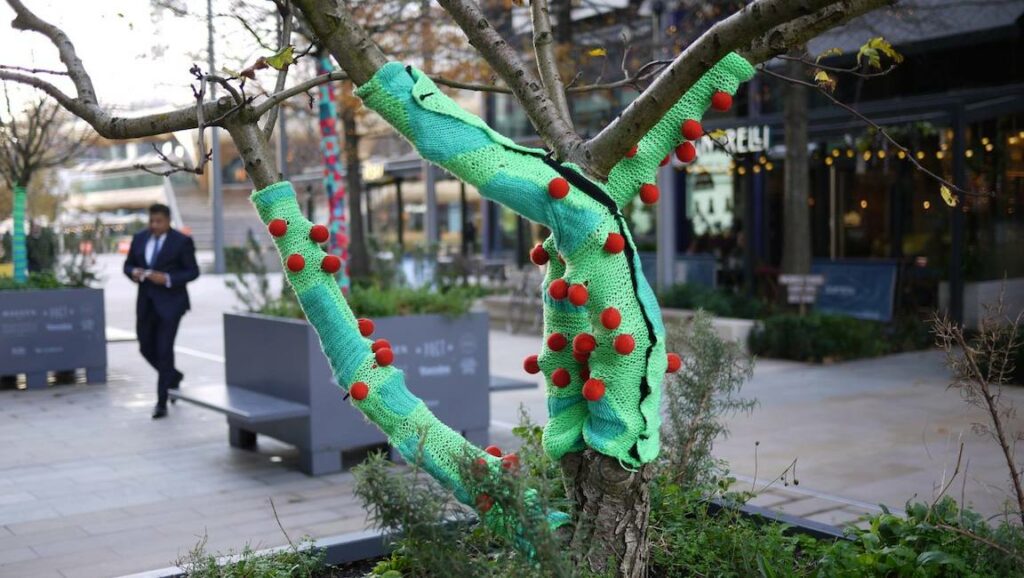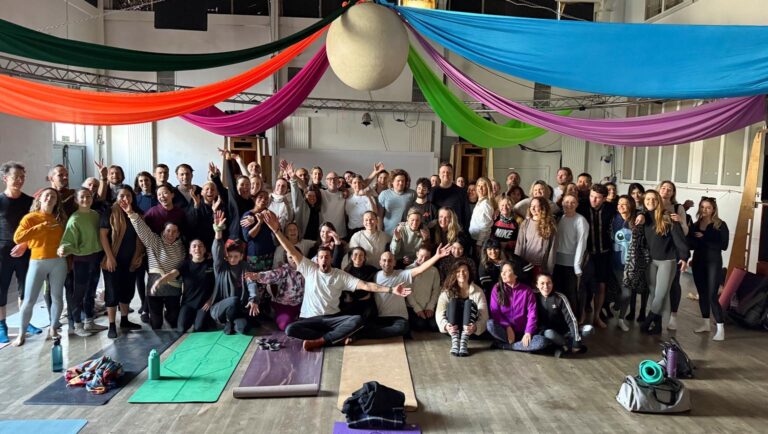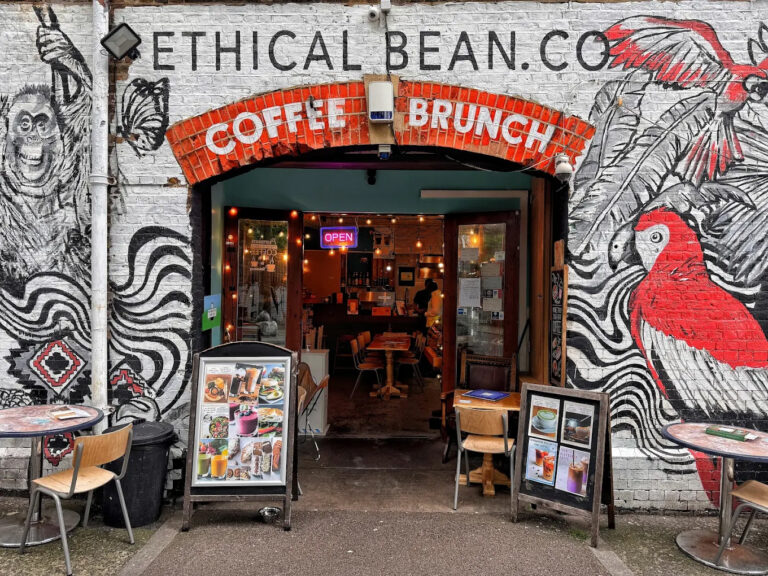
Review: Kokin – tuna meets fire at The Stratford
The new sushi restaurant now at the iconic skyscraper’s 7th floor and terrace
This winter in the neighbourhood, you’ll find some creative developments from up-and-coming artists. Yarn bombs are wrapping our trees thanks to local artist and designer Rosina Godwin, and we can also expect the Red Path to be revamped by a promising artist from the area. With the resources that big organisations have at their disposal, it is vital they provide opportunities for commissions to the artists of their community, and the chance to make a real impact.
Since 2021, Stratford’s Endeavour Square has housed 20 fruit trees as part of the area’s climate innovation mission. Now that the frosty months of the year have arrived, International Quarter London (IQL) have coated up the trees with their first ever ‘yarn bomb’ project.
Local artist and designer Rosina Godwin has reclaimed the space with a personal touch. The fluffy face of graffiti marks its presence as the collection brings knitted bands intended to meander between the branches, and custom pieces specially designed to accommodate the tree trunks. Rosina repurposes knitwear, such as used woollen sweaters, to create these vibrant tree trunk socks that encourage sustainability by highlighting inventive uses of recycled materials. Rosina’s ideas celebrate knitting and creativity by reclaiming and redefining what we do with our previously used clothing. The work combines fresh knitting with vintage pieces to demonstrate the artistic potential of recycled knitwear as well as the beauty of darning and mending.

Over the summer Rosina led Darn for Yarn local workshops, including one at the Olympic Park’s The Great Get Together back in July, where children and adults from the local community stitched their own very personal designs onto the custom-designed tree socks ready for the yarn bomb.
The project is about more than just a pretty installation however; Rosina really hopes it acts as a source of inspiration, too. “I hope the project will attract visitors to IQL’s mobile orchard, add a bold pop of colour and brighten the space through the long winter months,” she says. “If by seeing my yarn bomb it encourages visitors to have a go at knitting and create their own pieces from recycled textiles I would be absolutely thrilled.”
The hand-knitted pieces come in a variety of geometric and striped patterns, meaning all twenty trees come to life with some very eye- catching motifs, all inspired by the nearby architecture. IQL’s colours of magenta, orange, blue, and green are combined in the work, aimed to celebrate colour in a variety of scales and configurations, from the towering buildings to the delicate branches of the trees.

Techniques such as numerical art have been utilised; look out for lucky numbers such as 7 and 8, and the numbers 12 and 20, significant to the local area. The knitted art looks to draw upon our seasonal sensibilities and act as a source of warmth and joy.
Zenab Mumtaz, Socio-Economic Development Manager at Lendlease confirms their “overarching ambition is to have a meaningful impact on communities, and particularly to find ways that we can upskill people into jobs and careers. That’s why the workshop element of this project was so important,” she says, “and something that we’d like to scale up for future initiatives. By linking activations to our education projects, they can have wider, deeper impact and mean our public spaces truly serve the community.”
Rosina’s work for this commission has subverted the norms surrounding knitting and debunked the myth that it is exclusively a grandma’s hobby. Now more than ever, increasing numbers of young people are having a go at knitting as we also see this rise in youth fashion trends. Given the current environmental crisis, the yarn bomb project can be characterised as a peaceful protest: a fun and light hearted way to address the issues at hand. The project brings the space to life with a new twist, and inspires knitting as a fun and creative sustainable outlet for all types of people to try.
Catch the project any time day or night until 16th April at The Mobile Orchard, Endeavour Square, Stratford.

Public Realm Framework:
Improving the Red Path
Hackney Quest are working on plans to improve the Red Path in Hackney Wick. In a bid to make it safer, more attractive, and more functional, they have the support of the council and the local police Safer Neighbourhood Team, among others.
Local residents and those that use the route are encouraged to participate in the survey to communicate what they would like to see improved, added or changed to the path. The survey can also be accessed via QR code which has been attached to multiple posters along the way. The survey marks a positive step for the council, which encourages better improvements, with local people having real input and tangible opportunities to make a difference.
Area Regeneration Manager, Mathieu Rogers, states that the ambition for this piece of work is to “help Hackney Wick and Fish Island (HW&FI) to transition to a more sustainable, accessible, robust and legible environment, where the public realm enhances the creative potential of the area and creates space for communities to thrive. Particularly to advance the arts and culture.”
Through research undertaken by Hackney Quest in 2018, and by the RiseUpEast consortium in 2022, young people have consistently identified Red Path as a place that they do not feel safe. Met Police data indicates that there tend to be at least a handful of crimes committed on or near the path each month. Red Path was identified as an unsafe place during the recent ‘Safety of women and girls in Hackney’ consultation undertaken by the council, too – where it was described as “dark, quiet and remote”, or “isolated and dark” for instance.
Young Hackney recently opened a new youth hub and sports facility behind the Old Baths on Eastway. In fact, the Multi Use Games Area (MUGA) has just won an New London Architecture wellbeing award. Therefore, the Red Path is an important pedestrian route to this new local facility, but its lack of safety is blocking people accessing it as a way to get to important local centres that help enrich young people in the community.
In accordance with the public’s concerns, the council aims to recreate the path as one of safety and a place people enjoy to be in its own right. Plans are in place to improve the lighting and fix the fencing on either side. This is particularly significant for women who don’t feel safe walking alone when it’s dark. Additionally, in order to get the local community involved and provide opportunities for young people, the council hopes to commission a talented artist to create a mural/ art project for the walls of the path in order to rejuvenate the space.
Other projects such as The World Reimagined – a creative sculpture trail across England, that responds to themes about racial injustice – has also been a product of the work of local artists, see: theworldreimagined.org
Such projects are only the beginning of a call to action for local organisations to provide artists in their community unique opportunities to be commissioned. Because without them our trees would be cold, and our paths unsafe and unsightly.


The new sushi restaurant now at the iconic skyscraper’s 7th floor and terrace

Exploring the health advantages of belonging to something bigger than ourselves

Your timely reminder to go visit these amazing restaurants, bars and cafes this summer while we wait for better bridge access…
It’s important not to paint LLDC as the big, bad, development wolf. The remit of this organisation is simply huge. All over Queen Elizabeth Olympic Park are testaments to the successful legacy LLDC hopes to create. There are many moving parts, and over time, there will be millions of beating hearts.
The Hothouse is a name given to a cute little mini-Kew Gardens temperate house installed in the International Quarter London’s shiny new build. In it are fruit which the architects suggest will grow outdoors in Britain in 2050 if the current climate change forecasts come to pass. There is an oak planted in a Great British Garden, in the shadow of the London stadium. The oak was seeded at Kew Gardens. Fingers crossed it grows big and mighty, like all oaks should. An Olympic oak, around which millions of people will be inspired, in a thriving landscape, filled with a vibrant community, helping to turn the wheels of a massive vision; East London 2.0 – a world class hub of education, arts, culture and innovation.
So that’s how we all play a part in creating a sustainable future; our town planners do their bit, and we can do ours. Pop yourself on an allotment waiting list, and in the meantime, grow pea shoots on your windowsill. Wildflowers will attract those all-important bees. Buy local vegetables from East London’s many growing schemes and small farmers. Throw your seeds out on the street in a bit of guerrilla gardening.
If you don’t have the privilege of a sunlight-facing seed box, then simply put on your flip flops and jog on to the marshes where free food is available from Mother Nature. Wood ear fungus, chickweed and hairy bitter cress, laced with blackcurrant sage and pretty violet flowers, that’s what John the Poacher might gather on a day’s foraging. His iconic name comes from his youth; he still ferrets for rabbits on farmland and will happily catch you one to order.
“My parents were proper religious. All creatures great and small; I say eat the lot of them all,” John told me over a cheeky liquid lunch at The Cock Tavern in Hackney. He is proud of his own legacy. His foraging has played a part in many an East London success story, from the elderflower he provided for Square Root’s popular cola, to the fennel seeds he harvested for Land Chocolate. “One man’s waste is another man’s gold,” he tells me. “When I drop seeds off at Land Chocolate, I pick up their waste of bean husks, which I take to beer makers.”
The poorest parts of the world provide an important example of the circular economy; at the bottom of the human food chain are the litter pickers, who harvest what can be sold. Can John’s lesson in waste disposal teach us anything? Could our litter bins actually be goldmines? Our buildings actually generate energy? The answer is a very firm yes. A circular economy which may see less waste, less haste; that’s the dream.
A joint venture in collaborative local media from:


In partnership with

Regulated by IMRESSS, the Independent Monitor for the Press CIC.
For more info on our complaints policy, or to make a complaint, visit FAQ.
